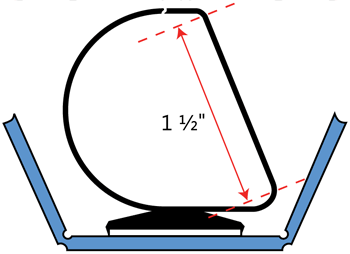
| Measuring
your binder:
Measure along the straight edge of the ring, as indicated by the red arrow. Do not include any of the curved part of the ring.
Capacities are in 1/4" to 1/2" increments, ande may be as much as 1/8" variation, depending upon manufacturer. For number of sheets
per capacity, see chart below.
|
Note: Generally D-ring binders will hold 25% more capacity
than
O-ring/Round Ring binders.
Ring Size
(measured as
shown above)
|
Number of sheets including indexes*
|
16#
Bond | 20#
Bond | 24#
Bond | 50#
Enamel
& Bond | 60#
Enamel
& Bond |
1/2" | 180 | 155
| 125
| 165
| 150
|
3/4" | 270
| 233
| 188
| 248
| 225 |
1" | 360
| 310
| 250
| 330
| 300
|
1 1/4" | 450
| 388
| 313
| 413
| 375
|
1 1/2" | 540
| 465 | 375
| 495
| 450
|
1 3/4"
| 630
| 534
| 438
| 578
| 525
|
2" | 720
| 620
| 500
| 660
| 600
|
2 1/2" | 900
| 775
| 625
| 825
| 750
|
*For tabs, deduct 4 sheets per tab from above totals.For example: 5 tabs = 20 sheets, which would be deducted from the above total number of sheets.
For larger binders, you can approximate the number of sheets by calculating from the totals above. For example, a 2" binder can hold up to 500 sheets of 24# bond, and a 1" binder can hold 250 sheets. Therefore, a 3" binder would be needed to hold up to 750 sheets.